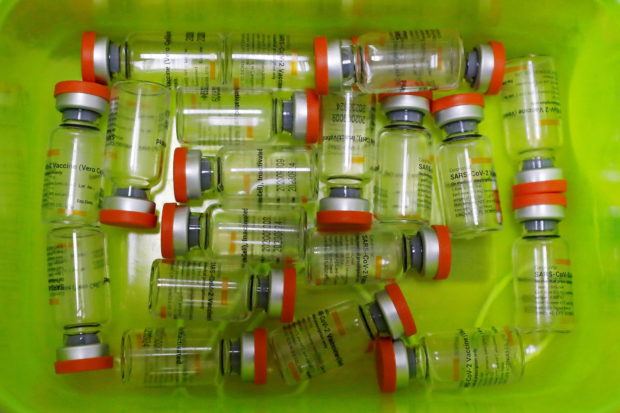OCTA urges gov’t to shorten interval for Sinovac, AstraZeneca doses

FILE PHOTO: Bottles of the Sinovac vaccine are seen at a hospital, as Indonesia drives mass vaccination for the coronavirus disease (COVID-19), in Jakarta, Indonesia, January 21, 2021. REUTERS/Willy Kurniawan
MANILA, Philippines — OCTA Research is urging the government to shorten the interval between administering two doses of COVID-19 vaccines made by Sinovac Biotech and AstraZeneca.
Fr. Nicanor Austriaco, OCTA Research fellow and molecular biologist, said Wednesday that this will accelerate the process of vaccination in order to protect more people against the Delta variant, especially in Metro Manila.
“We can fully vaccinate more people in the NCR in order to protect them from Delta. These are two recommendations: shorten the Sinovac two-dose interval into fourteen days… and for AstraZeneca, to shorten the two-dose interval to eight weeks,” he said in an online media forum.
The interval for administering two doses of the Sinovac vaccine that is being observed in the country is four weeks, while the interval for two doses of the AstraZeneca shot is 12 weeks.
According to Austriaco, a Turkish trial published in The Lancet journal showed that the Chinese vaccine offered 83.5 percent protection against symptomatic COVID-19 even with a two-week interval for two doses. He noted, however, that the trial used an earlier version of the SARS-CoV-2 virus.
“It shows that two doses is still effective, and we know that one dose of Sinovac is not as fully protective against any variant, let alone the Delta variant. So we would like to recommend to accelerate [the vaccination] and for the government to shorten the two dose interval to 14 days,” he said of the Sinovac shots.
Meanwhile, Austriaco also said that studies have shown that an eight-week interval for two doses of AstraZeneca is still effective and “responds to the Delta threat.”
OCTA Research is recommending a “circuit-breaker” lockdown or an early lockdown in Metro Manila to stem the imminent spread of the Delta variant.
Austriaco noted that the early lockdown also aims to accelerate vaccination in Metro Manila to achieve at least 30 percent population resilience against the highly transmissible variant.